|
SPECIFICATIONS Years: 1989-1991 Class: Sport Compact Type: Coupe Country: Japan Host: GT4 & GT5 Price of '89 GT-R: 15,474 cr. (GT4),
39,443 cr. (GT5) Mileage as Tested: 38,085.5
(GT4), 14,203.7 (GT5) Construction: unit steel Length: 178.9" // Width: 69.1" // Height: 52.75" Wheelbase: 103.0" Overhang: 6 feet 4 inches Track: 58.3" front and rear Ground
Clear: 5.3" Curb Weight: 3,152 pounds Seating: 2+2 Mileage: 14/23 Steering: power-assisted
rack & pinion + Super-HICAS Layout: Front Engine
/ All-Wheel Drive / ATTESA-ETS Tires: 225/50R-16 92v Suspension:
multilink, coils, shocks, anti-roll bars Brakes: vented discs The test car was not given oil change or any other maintenance for all specs & testing below Engine: 2.6 liter DOHC inline-6 Aspiration:
air-to-air intercooled twin turbo Fuel Syst: EFi Valves /
Cyl: 4 Bore x Stroke: 3.39 x 2.90" Compression: 8.5:1 Neither car had oil change or engine rebuild, for all specs & testing
below. They both rated near, or above, dealer-quoted power.
GT4
GT5 Horses: 275 @ 6,000
288 @ 6,800 Torque: 260 @ 4,400
273 @ 4,400 Credits / HP: 66.63 136.95
Pounds / HP: 11.46 10.94 Pnds / Torqu: 12.12 11.30
HP per Liter: 103.4 112.1
GT4 Idle: 1,000 // Redline: 7,500 // RPM Limit: 8,000 GT5 Idle: 750 // Redline: 7,500 // RPM Limit: 8,000 Transmission 5-speed manual Differential: open front, limited-slip center,
limited-slip rear
GT4 GT5 0-60 mph: 6.200
5.823 seconds 0-100 mph: 14.737
13.068 0-150 mph: @48.000
44.270 0-400 M: 14.737 @ 100
13.426 @ 101 mph 0-1 Kilom: 26.370 @ 129 25.766 @ 130 mph 0-1 Mile: No Test
35.671 @ 144 mph 100-zero mph: 3.717 secs
5.000 seconds Daytona Lap: No Test
58.554 Test Track Lap: No Test
No Test Top Speed at Redline (GT5) 1st: 41.0 mph 2nd: 67.0 3rd: 99.8 4th: 131.7 5th: 163.5 mph @ 6,600 rpm 161.4 mph @ 6,800 rpm (GT4)
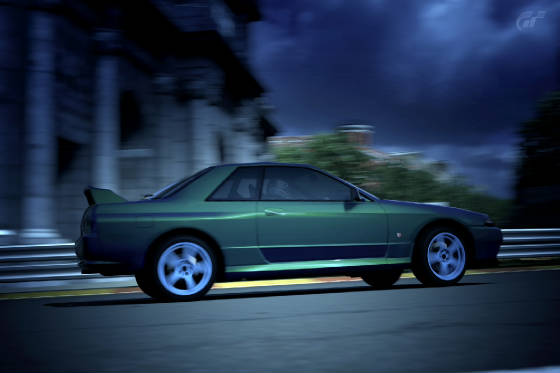
EXTERIOR / HISTORY------------------
1954. In the Year 1954 the cinematic world would change forever.
During the '50s, many moviegoers would become obsessed with horror films, undead beings, and monsters. Many of these monsters
became household names in a matter of no time: The Thing, The Creature from the Black Lagoon, a variety of aliens from
other planets, and the plant which devoured flesh in the Little Shop of Horrors (the one which said "Feeeed meeee!"). Many
of these monsters were invented by Hollow-wood (oops) I mean Hollywood, which means they were American creations.
But there was one which would become known from the other side of the globe, one who would cause a worldwide sensation
to this day. Godzilla seemed to have been inspired by both
King Kong and those fascinated by dinosaurs. Here we had a larger-than-a-dinosaur type of dinosaur who did things
only King Kong had managed before: running amok through cities, tearing them apart with his bare hands, causing entire
battalions to mobilize, entire villages to flee. Unlike King Kong, Godzilla did not have a particular human female he was
after; Godzilla only wanted to crush/kill/destroy. 1989. Up
until the Year 1989, the name "Godzilla" could only be used in reference to this gigantic creature from the movies; up until
the Year 1989 nobody thought the monster would actually come to life. Those who feared Godzilla
before 1989 might only need to remind themselves that he's just something to be seen in a movie. Right? 16. 16 is the number of years which had passed from the time Nissan gave up their quest to
create their best versions of their top automobiles, and for awhile it looked as if they would never try again. As the Skyline lineage faded from glorious winner to common milk-drinker, many thought perhaps the Skyline might
never again rise up to its former reign of terror on the racetracks, which (by 1989) had now become a series of mere paragraphs
in automotive textbooks, and mere screenshots on fading Super 8 film reels. We can relive the glory of Nissan's GT-R in various
forms of media basically, but not in real-life. Sure, Nissan's Z cars did plenty of damage in the world of IMSA, SCCA,
and WRC motorsports during the late '70s and into the '80s, but the Skyline was history,
and civilian versions of the Z were nothing to fear, with roughly 180 horses at best if we're talking
about the turbocharged ZX. Hmph. Yet there were hints, rumbles felt
along the earth, if you will, of something yet to come, something much more fearsome, terrifying and dangerous, and
it would not be the Z that showcased these tremors and intuitions. A thump along pavement. A growl one might think
he hears across an alleyway. Slowly but surely, the one to watch would be the Skyline, as it subtly
evolved its shape and strength. First, it got a turbo, then, a dual-overhead cam engine. The designation which followed the
word "Skyline" also danced around a lot, hinting at what was to come. There was the RS Turbo. The GT-ES. The GTS. GTS
Turbo. GTS-X. GTS-R. It's as if Nissan was teasing their fans, making them wonder and doubt. Ha ha, wonder why we're
giving our cars all these silly acronyms, Skyline Fans? Then, it happened. The moment of truth. The version everyone was waiting for finally showed its face in the Year 1989. 1989 was a rather special year in
the Japanese automotive world; not only did the Nissan everyone desired re-appear, but so did Mazda's 2-seater Miata, Subaru's
first Legacy, and Mitsubishi's first Eclipse. The 300ZX's newest edition also showed its new, rounded face. ...
All of these wound up becoming world-sellers, while Nissan's latest gem would wind up merely known to a select "few",
and mostly on the Eastern Hemisphere. Such a shame, too. The 1989 Nissan Skyline
GT-R would be the first to feature a long list of items developed during the 1980s in other Nissan vehicles, like ECCS fuel
injection and HICAS steering. The difference was the GT-R would step even further than anything previously seen. For instance,
there had never been an all-wheel drive Skyline before, and certainly not one which used a series of tricks to help it perform
even better than the average all-wheel drive car on the market. Subaru's AWD systems were mechanical and hydraulically-activated
for instance, while the GT-R's added computer technology. Mitsubishi's AWD systems may have been awesome off-road,
but on pavement they provided the driver plenty of understeer, with little hope for anything else. At least in 1989 this was
true. Nissan tried their best to eliminate all of this, while delivering only the better traits of an all-wheel drive drivetrain.
We know the rest...right? Godzilla? 29 consecutive wins in its first
year of life? So many wins over the next few years it was not only banned, but also caused rule changes,
re-classified entire categories of racing, and created a general fear amongst those who dared face the beast. ... yadda
yadda yadda. Japanese A-class racing basically shut its doors because after awhile, nobody wanted to compete against the GT-R.
Nobody could. Those who question why there are so many Skylines in Gran Turismo (and so many versions
of R32, R33, and R34 Skylines in particular) need only visit a history page on this vehicle. I believe there are three base-model Skyline GT-Rs from the R32 generation in GT4 and 5: 1989, 1991, and 1993. I
have yet to find any significant differences between them, oddly, other than model year. They all have the same dimensions,
are shod with the same tire sizes, and all boast the same engines & power, the only difference is some start with
more miles, and therefore less power, when we first buy them. Only thing that's noticed right off the bat is the latter cars
carry a bit more weight than the '89. The '91 GT-R weighs-in at 3,262 pounds for instance, while the '89 is 3,152. Perhaps
as each car is tuned things start to change, though. Who knows? I don't, and it'll take awhile to find out. To confuse Westerners like myself further, there are about a half-dozen extra designations to be found 'after'
the letters GT-R. These extra versions aren't just for show. Here are some of the features these monsters had which made them
superior to base model GT-Rs. GT-R N1: N1-reinforced engine for endurance-type
racing. The N1 was also lightened to 3,080 pounds, had lower-profile tires, and could only be had in a 'crystal white' paint
job. N1 cars did not have air conditioning, ABS brakes, and other such features, all in an effort to make these lighter. GT-R V-Spec: Featured four-pot Brembos with ventilated 324 mm discs front and two pot Brembos with ventilated
300mm discs rear. Also had an ATTESA E-TS 4 wheel drive system, and bigger 17″ x 8″ BBS aluminum alloy wheels
with 225/50 ZR 17 tires (the regular car has 16" wheels). GT-R V-Spec II:
Tire size was increased to 245/45 ZR17 due to N1 endurance (Gr.N) race regulations. There are also other GT-Rs to be found in our games, but these are touring cars and tuners, some specialized by Nismo:
Nissan's racing & tuning arm. So with all these versions clamoring for attention, this is why this review focuses upon
the base models. At least, that's what I'm going to try to do. In
1989, the GT-R could be had for 5,311,350 Japanese yen, or about $37,000, which is roughly the price we pay in Gran Turismo
5. In the 4th game, I've seen some of these for less than half this price though, so happy hunting for some 15K deals! Wait. You hear that? Something is coming. Somebody
is coming...
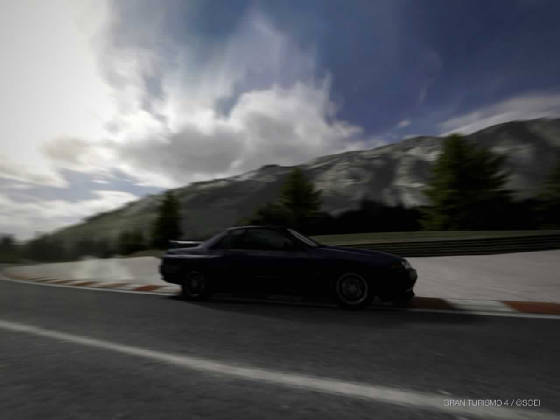
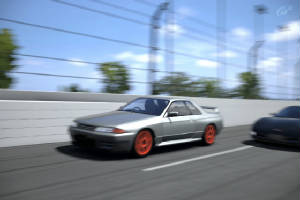
ENGINE / DRIVETRAIN------------------
GRROWWLLL!! Many cultures, creeds, and faiths theorize that when we die, something happens; and what that "something"
is tends to vary. Some say nothing happens. We just lie there in a box, while our mind perishes. Period. Others say we go
to a specific place: some religions will tell us we go to heaven, others say Shangri-La, others say the Happy Hunting Grounds.
Whatever. Hardly anyone agrees on the matter. That's why I'm not a big fan of religion. I have my own beliefs, and they're not nearly as confined as what 'they'
say. Hopefully one of them might be that we get to drive whatever the heck we want once we've passed, and are allowed full
freedom to explore far beyond what is capable on Earth, sort of like a dream come true. I'd like
a turn behind the wheel of an R32 Skyline GT-R if this is the case, and not a videogame version. Puurrrrrrrooooooooo! ...Goes that
straight-6 engine. RB26DETT, are you familiar with what that is? What it stands for? There are some folks
(PD's staff, for instance, and a good many of their fans) who must live and breathe that designation, they can recite
these complicated letters and numbers in their sleep, and rightly so. The RB26DETT-coded engine is what
first made its appearance in the Skyline GT-R. The GTS-t? The GTS-4? They merely got the RB20DET. 2.0 liters
versus 2.6. Nissan was saving the 2.6 for its top models, and although I'm not sure whether or not the press managed
to discover the 2.6 was about to be unleashed towards the end of the eighties, it must have been quite a moment when it was.
It is interesting no other cars in Nissan's lineage managed to find themselves graced with this particular engine. 8,000 RPMs of revving action. GT5 boasts some truly low acceleration
results: Zero to sixty miles per hour in a mere 5.823 seconds. 400 meters gone in (13.426 seconds) about
the time it takes to check a lottery ticket. www.supercars.net has a page on the R32 GT-R which claims 5.6 and 13.9 seconds respectably, which can easily be attained if one lets the car's
clutch in at higher revs than I do in my tests. The test car I drove in GT4 was significantly slower than this (6.200
seconds to 60 mph, 14.7 to 400 M) but it also started with 13 less horses, and I didn't bump it up with an oil change,
since its power starts very near what the dealer quotes. The car in GT5, on the other hand, starts with 288 hp, but probably
because its mileage was a lot less than the GT4 vehicle. We've got an overall top speed of 163.5 mph while stock (161 in GT4), and oh...just wait'll
you take a gander at what this car can be tuned up to on the aftermarket. But see. Dammit! SEE? I'm starting to do it!! "What's
that, Parnelli?" .. I'm starting to sound like
one of those media hype-machines; the ones who have absolutely nothing bad to say about the R32's top Godzilla. And this is
because .... there isn't much that's bad to say! There isn't much to be critical of in this department. About
the only thing I've got is the fact that the twin-turboed, air-to-air intercooled, 2.6 litered gizmo under that hood
is a bit lowish on torque when compared to others, and this is actually more of a feeling than anything tangible.
With 273 foot-pounds to start, the numbers are definitely there. But this one's not really as exciting to
drive virtually as some others with these same sort of numbers. It's due, of course, to this car's excellent all-wheel drive traction. *smacks head* ahh see! There I go
again with the hype! ... Hey, YOU try writing an article on a Skyline GT-R with all-wheel drive, let's see what YOU come up
with! Anyways, it's the fact that the Skyline's
ATTESA-ETS system (which stands for ... anyone? .. anyone? ... Advanced Total Traction Engineering System
for All terrain with Electronic Torque Split) is simply keyed to plunder. Keyed to survive.
And keyed to destroy. A less advanced system (ATTESA without the ETS part) first appeared in one of Nissan's Bluebirds
in 1987, shockingly enough; and also made an appearance in the infamous Pulsar...which was simply Nissan testing things for
the ultimate monster to come, of course. ATTESA featured a viscous (fluid-activated) center limited-slip differential
matched with open diffs front and rear. The engine's torque is constant to the rear, but uses a complicated system of fluid
transfer to vary input to the front. All of this is watched over by a 16 bit computer monitoring several g-sensors to determine
if the car needs more traction. Well, it certainly has such traction in droves off-the-line, as we can see from those acceleration
results. The Skyline GT-R eventually wound up with
a strategy which placed 100% of its engine's torque towards the rear as the car was driven in a straight line, but up to 50%
of this torque can be sent frontwards (as needed) in microseconds. Such an evolved piece of technology had never been seen
before in a production vehicle. Even top marques like Porsche, BMW, and some of the best from Italy would stand up and take
notice. On the other hand, this one is certainly not the quickest
once some upper-hand speed is involved. The GT-R's 5-speed transmission is a bit tall once we're racing at certain tracks
with tight areas to blast out of, and there are plenty of moments when this car doesn't feel as quick as it is. But ... that's
just me struggling to find something to criticize here. Even the transmission itself is often appropriate; all five gears
(including 1st out of certain super-slow areas) can potentially see use. One thing we certainly can't critique is available power. The R32 GT-R has been with us since the beginning in our
games, and although I don't have any specs for earlier games at this writing, take a look at what we've got in GT5: Horsepower
Torque Stock: 288 @ 6,800
273 @ 4,400 Stg 1: 425 @ 7,100 363
@ 5,100 Stg 2: 451 @ 7,200 380
@ 5,200 Stg 3: 470 @ 7,300 390
@ 5,300 And that's not all. That's just the engine
stages. Now we add the turbos on top of this... Trb
1: 562 @ 6,500 509 @ 5,300 Trb 2: 637 @ 6,100 559 @ 5,700 Trb 3: 645 @ 8,500 465 @ 6,100 Now if that's not something to write home to grandma about, I'm at a loss.
According to Pupik's GT2 website, the GT-Rs in that earlier game (almost all of them) make about 637 tops, so PD's been consistent between these two
games, at least. More hype? Okay! Power is always located
somewhere below redline, and Nismo gives us a good amount of leeway before we meet that RPM limiter. We can grab down low
for power often, too; during a 9-lap Arcade race at Madrid, I found I could use 1st gear out of this track's tightest hairpin
(Turn 1, basically) or I could choose 2nd. Choosing 2nd cast those revs down to 3,000 rpms. No problem. The RB26DETT can easily grab this low, and it's due to this option that I
was able to attempt either a quick (but sharper) launch out of this hairpin in 1st gear, or a lengthier torque-spool in 2nd,
which means the car's not going to lose that small amount of time upshifting. Turbo lag in either case is simply non-existent.
GT4 features a somewhat slower feeling than GT5 does during similar situations, but it's also safe to launch out of slower
areas in this game with some lowish revs. The main difference is that below 4,400 rpms (which is where peak torque is in this
game) turbo-lag begins to feast on our fun, even if we're using just a Stage 1 turbo. It seems more noticeable in this
game than it does in 5. Dammit. Time to
be quiet. Everybody take cover, Godzilla is about to arise...
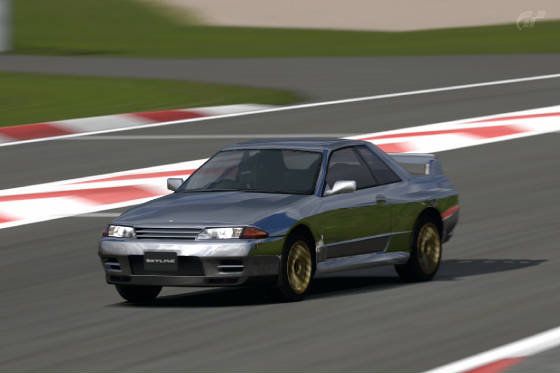
CHASSIS / DRIVETRAIN--------------
In Godzilla's first film of 1954, the idea was that the monster was born from radioactive fallout wastes
located somewhere off the coast of Japan. Godzilla symbolized "all the fears Japanese people had" after the destruction of
World War II some 9 years before, according to one website I visited. Godzilla was gigantic, careless, and clumsy as he stepped through blockades, pushed cars and vehicles aside
with his tail, and bashed his head into buildings. He didn't need to be precise or careful or diligent. Now, the car-Godzilla? Here we have a different story. In this case, Godzilla
happens to be all these things at the latter end of that last paragraph: it steers and brakes-in precisely as it's driven,
carefully lays out its feet as it's tested, and diligently manages to make 1st place win after 1st place win, assuming the
driver's not so specific with any sort of limitations while racing. But even with limitations in place, the R32 GT-R's variety
of acronymic systems (ABS, ATTESA, Super-HICAS, ECCS), keep this beast rocketing forward with all kinds of menace and glory.
Good thing for this car reviews website! Honestly, I can't find many flaws with this car's engine, nor are there many with its drivetrain. But handling?
Yes, there are some. In the Years approaching 1989
Nissan was preparing to enter the world of racing. At the time, tire width was limited to 10 inches, and the Skyline they
were preparing was still rear-drive. Nissan knew the GT-R would rise again, and wanted to make sure that it did so in a way
which would dominate, just as the KPGC10 did so long ago. Eventually, somebody came up with the idea of aiming this car towards
Japanese Touring Car's A-class, and also decided to make it all-wheel drive. With this decision, wider 11 inch tires were
now an option, as well as more power from a larger engine. The only catch was Nissan had to sell 500 R32 GT-Rs to the
public. Lucky them. But this is apparently why the R32 GT-R in our games is 'stuck' with 225-width tires instead of something wider. Not bad, but notice
that latter editions of GT-R had tires which were even better. GT4 The thing is, here we have somewhat of a paradox. Godzilla in ... Gran Turismo 4? Can this really happen? Hmmm.
Drove a GT-R around El Capitan with its standard
medium sport tires, and then I also did some races in the Tuning Car Grand Prix, but these races were done with racing slick
tires, so we really can't judge the GT-R's handling with these. Ironically, I've driven the car in GT5 before driving the
one in GT4, so there might be some backwards-comparisons, here. So
with just the sports (no race), what we've got is a mixture of razor-sharp cornering mixed with some godawful understeer here
and there. It really gets bad, too: entry, mid-turn, or exit. Not really very 'Godzilla-like' so far. The understeer
one must occasionally face is just as common as what might be found in many other cars in this game, and it can ruin
our day at any time. None of this is really a surprise, of course, this IS GT4, after all. And really,
it's not the fact that the GT-R understeers, it's how easily it can understeer. It's one of those things which simply
shows up just a little too easily! So
what can we do about this? The trick is to know your braking zones. Once you know and respect them, it becomes possible
to start driving a very predictable machine, instead of something which feels more like a Mitsubishi GTO than a
Skyline. Unlike the GT0, the GT-R does give more leeway between slip and grip. Still, though... The braking itself is outstanding, of course. Braking is ridiculously easy
in the earlier GT games, so there really is no excuse not to utilize. Still though, there are times when plenty of braking
has been employed, and this car still pushes mightily mid-turn. It goes away, but then can come right back,
with just a tap too much gas too early. Unlike the
car in GT5, there isn't enough throttlesteering to save us if we need this, unless we're in a turn which
is really wide. Think Route 246 / Turn 4, for instance. Otherwise, the R32 GT-R in this game tends to drive without any real
assistance. The front-end also doesn't often react enough with lift-off, even after those tires warm up. The only exception
to this is if we've got some racing tires on. But with sports in place? Nissan's HiCAS steering system is definitely here, and we can begin to feel
its presence especially with racing tires on, but it barely makes a dent with sport tires. You'll be lucky if you get through
some turns without any pushing up front. Ironically, it's the rear-drive Skylines in GT4 which feel much more rear-steering
with HiCAS than the GT-Rs. They tend to have a feeling like their rears are maneuvering with slight extra zest. But these
guys also understeer a little too easily, too. Other
than these critiques, the GT-R does well. It handles the bumps and undulations of El Capitan (and a couple other tracks I
drove at) with little fuss. Traction is always guaranteed. Those who don't need to rely on damage control will find that this
Nissan has plenty of moments when it corners as if it's on rails, like so many other AWDs. It feels solid, even with its stock
suspension, and I've been noticing how 'floaty' some of those rear-drive Skylines feel in comparison, with their stock parts.
So ... Godzilla? This was an honor bestowed
upon those who cruised solely on some racing tarmac, which (in my opinion) does not get shared by what I just drove. And the
GT-R in GT5 is much more interesting to drive, yet it's also nowhere near perfect... GT5 As this car is driven mildly, once again, there's not much to criticize. But as it's driven more harshly and then
raced, especially with some power restrictive action, now we've got some issues. #1 happens to be the front end,
which begins to push with varying amounts, either slightly or (in some cases) with downright hayseed-planting understeer.
While racing an '89 GT-R in GT5's Supercar Festival, it's the front end which needs the most attention. Yes, Nissan had done
all they can to avoid understeer with R32; they've configured a rearward torque-split and backed this up with computers, but
there are times this car can't help but plow like any other front-engine / all-wheel drive doofus on the roads. As I prepared a silver/chrome (oh yes I did) colored '91 base model GT-R for
that first race at High Speed Ring II, I made sure it was equipped with its default hard sport tires. This car has just over
45,000 miles on it, and since nobody in the imaginary world of GT seems to know how to perform maintenance (but us), oil was
changed and the engine rebuilt. This resulted in a 314 horsepower engine with 298 foot-pounds.
The goal would be to drive this car in such a state around this track for a few laps, and eventually tune it upwards until
it matched the 421 horses required by the Sports Car Class. What would it need to survive? Could this car get away with
no suspension, brake, or drivetrain tuning once the race was on? First thing that's noticed is the subtle variety of cornering options this car presents. It always turns-in initially,
that's not a prob, but from here on things can differ a bit. Sometimes the front pushes slightly while entering HSR's
steep banks, and there's not much we can do about this. Other times, it'll tackle the exact same turn with a helpful bit of
nose-in after a one or two-second delay. There are times this car graces mid-turn so neutrally, it's got that typical "on-rails"
feeling AWDs often display. Other times, it's possible to nudge the throttle at just the right time, and now the car's doing
a bit of rear-steering, its HICAS now here to help. Overall,
it's hard to say what's really happening, unlike that Legacy or Galant from the GT-R's day. Is the Nissan's computer making
some hidden decision? Or is it laying dormant, letting those tires, axles, and torque converter do their thing
in solo-mode? The GT-R is a somewhat mysterious machine in such a way, but there are always some givens. Braking is
always solid, with near-zero issues with sliding or body-sway. The car does turn-in while braking too, but eventually meets
a typical AWD limit (in the sense that it won't just do a donut on-entry). The car's traction is also flawless. Check, check,
check. I decided I'd power the car up to 421
horses, but keep the hard sports on. Let's see if we can make Chromium Godzilla sweat a little bit. One quick note though
before this is done, though: I noticed that the GT-R posted a time of 1:20.674 at this track, making 8th
place, and less than a second behind a 2010 Camaro SS which would have had nearly a 100 more horsepower. Either that
car's 1:19 was flawed, or the GT-R really is that good. Under such conditions, not much changes, though. The car still has a slight push mixed in with other behaviors, and
I thought perhaps I could make a wheel spin, a tire squeal more overtly, ANYTHING, but the GT-R always manages to behave at
this track, and with its stock tires. Leaving this tracks two flat (non-banked) turns while plastering that gas-pedal,
there's sometimes a moment when it seems the rear-end's about to lose some of its traction, the rear actually starts
to step out a bit forcefully. But then something happens, some decision by some authority somewhere in that computer seems
to get made. And the wanton behavior then STOPS. Goodness. So there isn't much to report for the actual race, which was done with soft sports instead of hard sports. I noticed
that sometimes the front-end turned-in with lift-off a tad quicker than it did with hard tires equipped, the problem is this
behavior is not always a given. Sometimes the car allows this, other times it won't, and now here it is stuck in a cornering
line that feels about as flexible as a bayonet stuck in a wine barrel. Bayonet stuck in wine barrel. How the hell did I just
come up with that? But overall, not
many problems at High Speed Ring II, and I did not expect many, either. On the other hand, at Nürburgring's GP/F circuit,
there was a lot more to report in the manner of problems to be solved. Lots more pushing up-front, which can show up while
entering or while exiting. Now, it's not the sort of pushing we'd see in a locker room from a set of bullies, nor is it muscle-car
type pushing. It's not as bad as I'm making it sound, is what I mean to say, but when it comes to the actual race itself,
it's obvious there's a little too much front-end understeer for comfort at times. With a 5-second 100 to zero mph time, this
car's got effective brakes, but it hasn't got the absolute Brembo Best Braking we'd see from a GT-R V-spec. The
bottom line though is to use this car's serviceable Nissan brakes to best advantage. They're there to help, for there are
times the actual computer systems can't always do so. Even if there is no pushing, the braking is appropriate, and the car turns-in flawlessly, if any sort of adjustments
are needed, especially during that crucial entry-to-midturn area, there's not usually any leeway to make these extra adjustments.
Not with hard sport tires, anyways. On the other hand,
while leaving turns, especially at this track, the GT-R's combination of gizmos does often assist in many
fabulous ways. I remember driving a Mitsubishi 3000GT many months ago at this very same track, preparing for this very same
race. The 3000GT had similar problems with pushing on-entry (as many all-wheel drives do), but the difference is it offered
NO assistance while leaving GP/F's variety of turns. At least the Nissan often removes the typical front-end 'on-rails'
AWD feeling, and replaces it with a bit of rear-end throttlesteering! Out of Turn 1, I could even choose 1st gear, which'll
cause the Skyline to lurch sideways (finally) with a bit of rear-sliding. This behavior is (of course) short-lived, but the
bottom line is this system is definitely superior to the mess experienced in that Mitsubishi. On the other hand, this sort of behavior is not always 100% reliable. There
are times when the Skyline's throttle is kicked a tad early (or something) and the computer seems to decide "oh,
you want to go a little wide? No problem" when it turns out I didn't want to go a little wide. I wanted to get
that golden steering-from-the-rear action of the last lap. It's as if the computer can perform its magic, but sometimes it's
gotta be tricked into doing so. Has something to do with the precise moment gas is plotted down, while the steering
wheel is turned just so, and the car's on an angle that its gravitational sensors can work with. So there ya have it: an honest car review on the one everybody loves to hype.
I've tried my best to splatter Godzilla with some mud, and it might be a good idea to run and hide from the beast before he
comes and gets us!
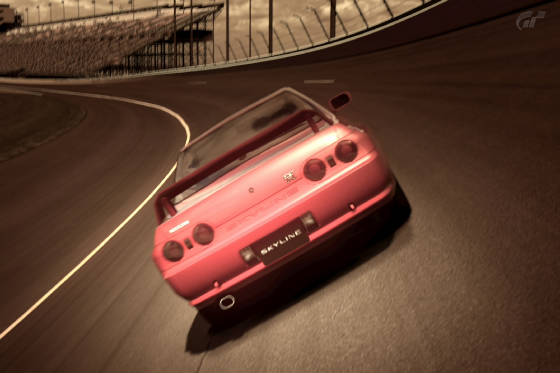
Pros 1). Yeah, it's a Skyline. 2). Lots of gut-wrenching turbocharged power from that RB26DETT engine. 3). This car lays its wide torqueband out, smooth as oil, which is why the GT-R is such an easy supercar for a
novice sort of driver than many others. 4). Traction
so flawless, I have yet to really see this car's tires smoke or slide no matter how hard it's driven. This includes GT5, where
oversteer issues are somewhat more prevalent. 5).
That purring engine sound. While it's not anywhere near my favorite, it's certainly a Pro for lots of people out there. 6). 5-speed gearbox feels a bit tall for some applications, but the only criticism
one can make in this day and age (it's not a 6-speed) can't be applied for a car from 1989 to '98. 6-speeds were not in vogue
yet, you see. 7). Acceleration that never needs
to be addressed. Aerodynamically ready for 160+ miles-per-hour right from the dealer. 8). Lots of tuning options so far as power goes, too. Oh yeah. GT5 only includes the usual 3 turbo kits, but some
other games include Stages 4 and 5, too. 9). Priced
appropriately for all the performance to be had. Easy to find an R32, as well, even in GT5. Used versions in GT4 are simply
dirt-cheap, most of the time. 10). GT5:
large mirrors if the driver's using the in-car view. Cons 1). R32 generation Skylines are the blandest in my
opinion. There's no yawning, darkened grille, the spoilers and wings are subtly attached to contemporary bodywork. Nothing
intimidating, and not much style going on here. 2). 160 mph speedo in a
car that can go faster than this while it's power is at minimum? 3). Read
most any words on the GT-R, and there's nothing but good stuff so far as handling goes. In truth, these cars push if pushed,
their front-ends occasionally prone to understeer that can (sometimes) barely be manipulated. Lift-off and throttlesteer can
happen, but this is not always reliable. The GT-R's otherwise flawless handling can make for a
rather dull experience too, driving-wise. 4). Too many versions of the 'same
car'. I struggled to find the difference between an '89 and a '91, for instance, which is a few less pounds for the earlier
car, a few more for the latter. 5). Despite their dominance on the tracks,
R32s aren't very fun to watch as they tackle every turn with a lack of dramatic impetus. Published: January 12, 2014 Edited for GT4: April 6, 2015
|
